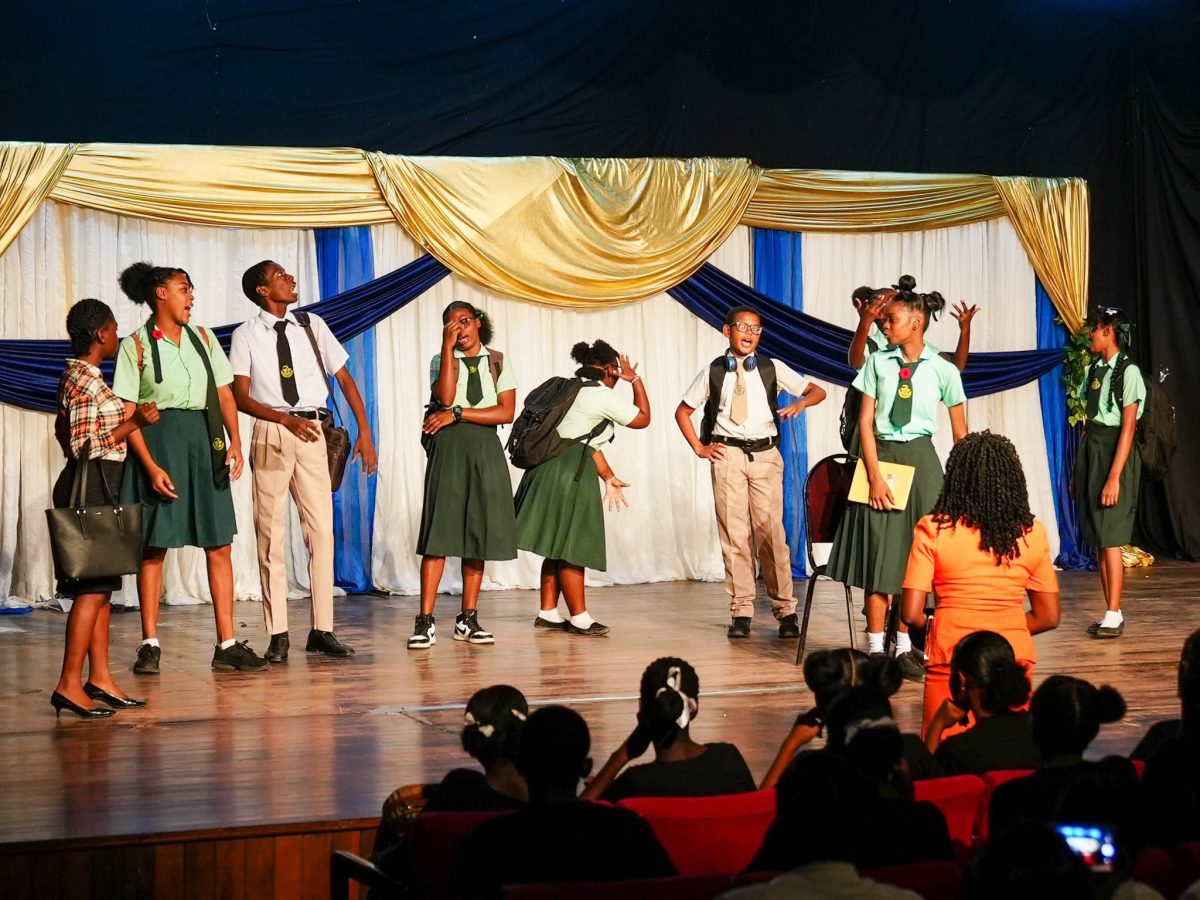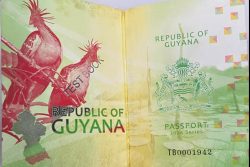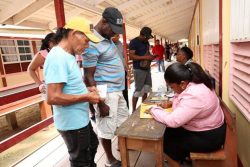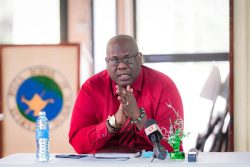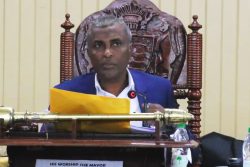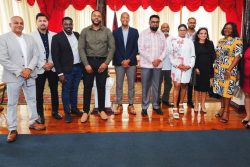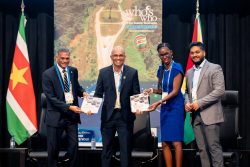 On November 11 the Unit of Allied Arts (UAA) in the Ministry of Education staged the Secondary Schools Choral Speaking Festival 2022 in Guyana. This theatrical event saw 10 schools from five geographical regions compete for prizes at the Theatre Guild Playhouse. There were several admirable things, a number of progressive factors and as many questions over this development.
On November 11 the Unit of Allied Arts (UAA) in the Ministry of Education staged the Secondary Schools Choral Speaking Festival 2022 in Guyana. This theatrical event saw 10 schools from five geographical regions compete for prizes at the Theatre Guild Playhouse. There were several admirable things, a number of progressive factors and as many questions over this development.
The formalities included those largely responsible for the festival, such as Kurt Braithwaite, Acting Administrator for the UAA, actress La Vonne George, Drama Specialist in the UAA and actor-director Randolph Critchlow, Chief Judge of the performances. The Education Ministry was represented by Senior Education Officer Sheldon Granville. The performances exhibited a range of subjects, interests and styles, moving from conformity to imagination. It was an impactful production and quite a notable achievement.
The first prize was emphatically earned by New Amsterdam Secondary directed by Oretta John with a performance of “Guyanese Folklore”. Second place went to Uitvlugt Secondary, coached by Candacy Whaul, who performed “The Beauty of Music”, and Charlestown Secondary with “Perspective” directed by Antacia Thomas claimed the third prize.
This marked a laudable development with congratulations due to the UAA and Ministry for what seems to be the return of the art of Choral Speaking and further attention to drama in secondary schools in Guyana. An inter-schools competition was an effective way of making this re-introduction of an art long thought to be forgotten in Guyana and of injecting some energy into the flagging state of local theatre.
The Guild Playhouse rocked with this energy, powered by the interest shown among the enthusiastic school students who filled the house beyond capacity. It would tax the memory to cite the last major appearance of choral speaking on the public stage, beyond the inclusion of items in the recent productions of “Unmasked” by Lloyd and D’Arts and “Greens and Golds” by Kreative Arts. One would have to reach back to the last National Music Festival, which now seems like a generation ago. But this competition resurrected life into the art and surely seemed to have captivated the imagination of the students.
In terms of public theatre as a whole, it helped to fill a vacancy left by the absence of the National Drama Festival (NDF) which ceased to attract government funding since 2017 and is now expecting a revival. A major advancement was made when the Schools Drama Festival was integrated into the annual NDF, giving it national prominence, increased prize money and a wider scope of achievement opportunities. It also helped to stablise high school drama and ensure annual activity. Besides, the National School of Theatre Arts and Drama (NSTAD), which was responsible for the NDF, partnered with the UAA to include schools in the Mentorship Scheme under which instructors were sent into schools to assist them with dramatic production.
But all of this halted with the disappearance of the NDF. The choral speaking festival was therefore additionally timely. It is one step in the direction of greater interest and of public theatre activity in schools. It is significant that four of the schools in the festival offer the CXC Theatre Arts as a CSEC subject. A rejuvenation in choral speaking will fortify the study of drama in the schools where it exists and offer encouragement for introducing it in other schools. It is of further interest that two of the top three schools in the competition offer Theatre Arts as a subject, and the only school among the ten contestants to offer Performing Arts at CAPE actually won the competition. It is not surprising that they exhibited the most dramatic accomplishment.
Another point of progress is the approach to choral speaking as a performing art form. It is an old form in schools in the Caribbean dating back to colonial times. It was therefore imported and inherited from the Eisteddfod and the Elocution. The Eisteddfod was derived from the Welsh and was an annual competition including drama, music, choral speaking and elocution. There emerged a postcolonial debate about style. For example, elocution was held to be the art of oral performance using the voice and dramatic intonation, perhaps the eyes and facial expression, but no gestures or stage movement. The debate surrounded whether it qualified as true elocution if the performance was fortified by the hands, body and stage movements.
It has a long history. No less than Shakespeare, himself, commented on it. Prince Hamlet of Denmark gave instructions to the actors that he hired to help him execute “the play’s the thing wherein I’ll catch the conscience of the king”. He admonished them to “speak the speech I pray you, . . . trippingly on the tongue. Nor do not saw the air too much with your hand thus.”
The great Sir Laurence Olivier delivered Hamlet’s most famous “to be or not to be” speech with his hands motionless at his sides. But in the Caribbean, as far back as perhaps nearly 40 years ago, there was a change of approach first seen in the performance of some of the most prominent choirs on stage – The University Singers of Mona, Jamaica; the NDTC Singers, who introduced pronounced stage and body movement in performances where choirs before stood erect, poised and still. The same began to creep into elocution, which was overcome by Caribbean performance.
Many of the schools in the recent festival moved quite away from elocution and the conventional choral choirs and presented Caribbean performance with much movement and dramatisation. While some interpreted standard works, like “The Pilgrim’s Progress”, Carter’s “This Is The Dark Time” or Goodison’s “The Woman Speaks To The Man Who Employed Her Son”, others opted for the more dramatic, such as “Ol Higue”. Yet others, whose teachers are dramatists, such as Keon Heywood at Ann’s Grove Secondary, Antacia Thomas at Charlestown and Oretta John at New Amsterdam, composed original performances. These called for a good deal of dramatic stage movement and moved well away from the conventional choral speech or elocution.
However, despite the packed auditorium and lively enthusiasm, the experience was quite limited. The Theatre Guild Playhouse only seats 300, the festival was held on a Friday morning and only 10 schools were selected to compete – two each representing Georgetown and four regions. The competitors were picked by UAA. It is not known why there was this limited participation.
This means then, that the widest range of schools did not benefit from this exercise. There is no guarantee that any other schools around the country are at all involved in this revival of dramatic activity. Neither is it known that those schools studying Theatre Arts or CAPE will derive any benefit from it. Valuable as it is, then, it is much too restricted. Additionally, it is not known whether this festival was a one-off occasion, or whether there is any intention of repeating it or making it a permanent or annual event. If that is the case, how will it be organized in the future? Will anything be done to involve all the schools.
Another observation is that the schools traditionally known as the senior secondary schools were absent – there were only at most two of them who competed. In past years – alas! many past years ago, the same schools that were regarded as the high flying institutions, excelling in academics, were also the leading schools in drama. That has now fallen off. Those schools no longer dominate, and are not even heard of in the once major high profile championships like the JOF Haynes Debating Competition.
Those schools no longer stage dramatic plays and were no longer prominent in the drama festivals when they were last held. While there has been welcomed ascendancy of the so-called junior secondary schools, there was a decline among the senior ones. In fact, the flag was kept flying by only one private secondary school – The Georgetown International Academy, popularly called The American School, who had annual public productions led by Subraj Singh.
At the same time, a few schools involved in the CSEC Theatre Arts used their practical performances to stage public community theatre to which members of the public were invited. These included Tutorial Academy and Berbice Educational Institute in New Amsterdam, South Ruimveldt Secondary and West Demerara.
In that context, this revival of choral speaking, however restricted, was a major boost. According to the popular saying “Half a loaf is better than nothing”; but half a loaf was never seen as acceptable, and it was always insisted that there should be the whole loaf. The plans of the Unit of Allied Arts in this area are not clear, but they might need to get back to their ovens and rekindle the fire.
